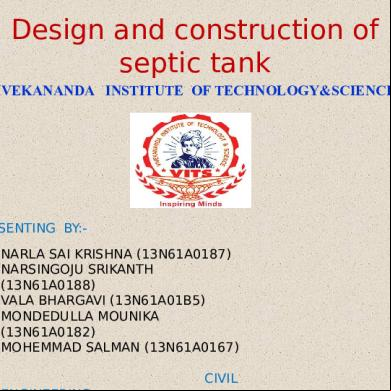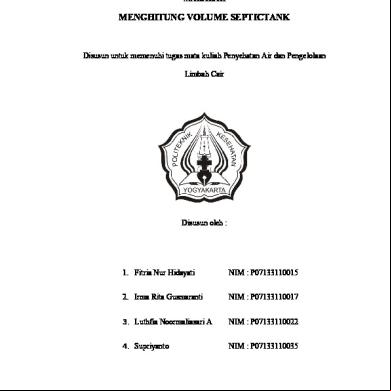Septic Tank Presentation Ppt 10n4m
This document was ed by and they confirmed that they have the permission to share it. If you are author or own the copyright of this book, please report to us by using this report form. Report 3b7i
Overview 3e4r5l
& View Septic Tank Presentation Ppt as PDF for free.
More details w3441
- Words: 569
- Pages: 16
Design and construction of septic tank VIVEKANANDA INSTITUTE OF TECHNOLOGY&SCIENCE
PRESENTING BY:NARLA SAI KRISHNA (13N61A0187) NARSINGOJU SRIKANTH (13N61A0188) VALA BHARGAVI (13N61A01B5) MONDEDULLA MOUNIKA (13N61A0182) MOHEMMAD SALMAN (13N61A0167) CIVIL
Aim Of Septic Tank • Septic Tank is in the form of Concrete box which has their unique designs. • The size depends on the number of persons in the house.
“Septic” refers to the anaerobical bacteria which digest the solids. It helps in removal of waste generates from bathroom, kitchen, laundry etc.
Introduction Septic tanks are widely used in many places because of many advantages such as stable handling performance, even when the wastewater has large fluctuations, occupying a small area, cheap, and the construction, management are simple, so they are easy to be
Design criteria(Septic Tank): • • • • • • •
Quantity of sludge -30 l/capita/ years Sludge storage Depth - 1.2 – 1.8 m Length: Breadth - 2-4 times Min width - 120cm Outlet ~ in let level difference = 5-7.5 or up to 15 cm Detention time = 24 hours Free board: 30cm
Construction procedure PCC(Plane cement concrete) bed Form work. Concrete filling in form work. Construction of the slab of tank. (using formwork)
Our design to sewer deposal tank • Length = 4.1m • Width of the tank = 1.6m • Depth of the tank = 2.2m • Concrete designed and used for tank=2.88cum • Steel designed and used for tank = 145kg
Form work
Septic Tank
Construction, installation of septic tank Septic tanks are built of brick, precast reinforced concrete or reinforced concrete poured in place, or made available by materials such as composites, HDPE, ... Septic tanks must be built tight, close. ). The width of the hole at least 200 mm vacuum residue. Where the septic tank cover set below ground, must have neck knit cap. knit cap is constructed of brick, reinforced
Two kinds of bacteria • Anaerobic –
living or occurring without
oxygen
• Aerobic oxygen
organisms & processes that require
Septic Tank Works
TANK MAINTAINANCE Septic system maintenance is often compared to automobile maintenance because only a little effort on a regular basis can save a lot of money and significantly prolong the life of the system. Annual inspections of your septic system are recommended to ensure that it is working properly and to determine when the septic tank should be pumped. Systems that have moving parts may require more frequent inspections.
Environmental concerns
Odor and gas emissions Groundwater pollution Surface water pollution
Advantages
-Can be built and repaired with locally available m -No real problems with flies or odors if used corre -Simple and robust technology -No electrical energy is required -Little space required due to underground constru -Low operating costs -Long service life -Small land area required (can be built undergrou
CONCLUSION
Current septic tank technologies are capable of treating wastewater (onsite) to a higher level of quality than do the vast majority of municipal treatment plants. The septic tank is only one part of an on-site wastewater system. It is designed to remove solids prior to the effluent entering the soil absorption field, provide for the filtration, digestion of a portion of those solids, and storage of the remaining solids. In our country environment it is not possible to release effluent to leach field, But it is possible in villages. The farmers can use their lands of crop as leach field.
PRESENTING BY:NARLA SAI KRISHNA (13N61A0187) NARSINGOJU SRIKANTH (13N61A0188) VALA BHARGAVI (13N61A01B5) MONDEDULLA MOUNIKA (13N61A0182) MOHEMMAD SALMAN (13N61A0167) CIVIL
Aim Of Septic Tank • Septic Tank is in the form of Concrete box which has their unique designs. • The size depends on the number of persons in the house.
“Septic” refers to the anaerobical bacteria which digest the solids. It helps in removal of waste generates from bathroom, kitchen, laundry etc.
Introduction Septic tanks are widely used in many places because of many advantages such as stable handling performance, even when the wastewater has large fluctuations, occupying a small area, cheap, and the construction, management are simple, so they are easy to be
Design criteria(Septic Tank): • • • • • • •
Quantity of sludge -30 l/capita/ years Sludge storage Depth - 1.2 – 1.8 m Length: Breadth - 2-4 times Min width - 120cm Outlet ~ in let level difference = 5-7.5 or up to 15 cm Detention time = 24 hours Free board: 30cm
Construction procedure PCC(Plane cement concrete) bed Form work. Concrete filling in form work. Construction of the slab of tank. (using formwork)
Our design to sewer deposal tank • Length = 4.1m • Width of the tank = 1.6m • Depth of the tank = 2.2m • Concrete designed and used for tank=2.88cum • Steel designed and used for tank = 145kg
Form work
Septic Tank
Construction, installation of septic tank Septic tanks are built of brick, precast reinforced concrete or reinforced concrete poured in place, or made available by materials such as composites, HDPE, ... Septic tanks must be built tight, close. ). The width of the hole at least 200 mm vacuum residue. Where the septic tank cover set below ground, must have neck knit cap. knit cap is constructed of brick, reinforced
Two kinds of bacteria • Anaerobic –
living or occurring without
oxygen
• Aerobic oxygen
organisms & processes that require
Septic Tank Works
TANK MAINTAINANCE Septic system maintenance is often compared to automobile maintenance because only a little effort on a regular basis can save a lot of money and significantly prolong the life of the system. Annual inspections of your septic system are recommended to ensure that it is working properly and to determine when the septic tank should be pumped. Systems that have moving parts may require more frequent inspections.
Environmental concerns
Odor and gas emissions Groundwater pollution Surface water pollution
Advantages
-Can be built and repaired with locally available m -No real problems with flies or odors if used corre -Simple and robust technology -No electrical energy is required -Little space required due to underground constru -Low operating costs -Long service life -Small land area required (can be built undergrou
CONCLUSION
Current septic tank technologies are capable of treating wastewater (onsite) to a higher level of quality than do the vast majority of municipal treatment plants. The septic tank is only one part of an on-site wastewater system. It is designed to remove solids prior to the effluent entering the soil absorption field, provide for the filtration, digestion of a portion of those solids, and storage of the remaining solids. In our country environment it is not possible to release effluent to leach field, But it is possible in villages. The farmers can use their lands of crop as leach field.










